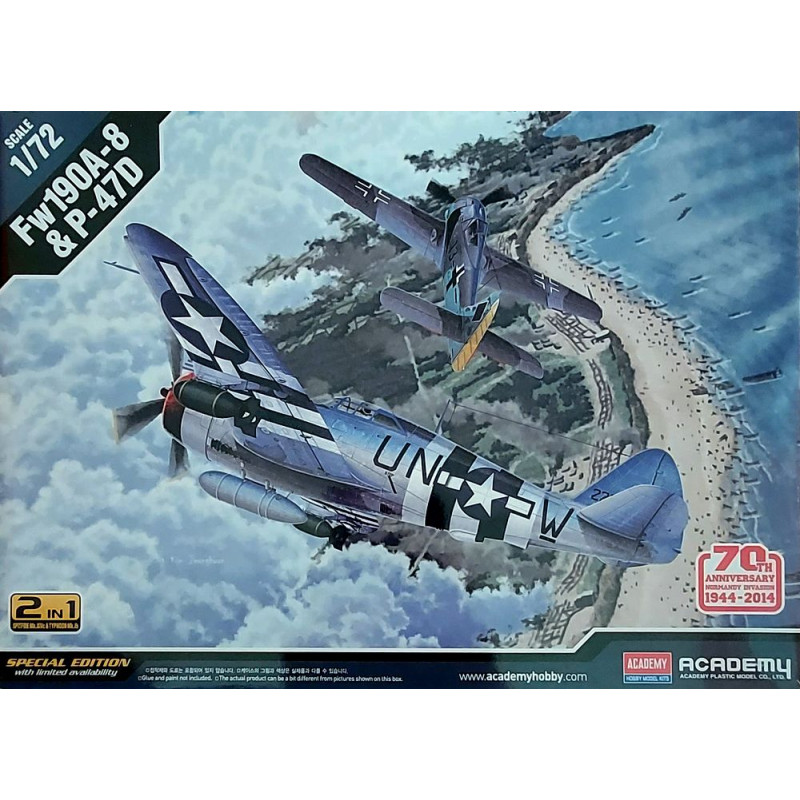The Focke-Wulf Fw190 is a single-seat, single-engine German fighter aircraft of World War II.
At the end of 1937, the Reich Air Ministry ( Reichsluftfahrtministerium - RLM ) sent an inquiry to production plants in Germany giving specifications for a new fighter, which was to be an alternative to the Bf109 if it turned out that aircraft from other countries were better than the Messerchmitt.
The project started in 1938, a wooden mock-up of the aircraft was built at the beginning of the year, and construction of the Fw 190 V-1 prototype began in the autumn. The flight took place on June 1, 1939 at Bremen airport by the factory's chief flight engineer Hans Sander. The aircraft met the intended requirements, and also had a few flaws. After the flight, it was transferred for further testing to the Luftwaffe facility in Rechlin, where during flights it reached a dizzying - for the time - speed of 595 km/h at an altitude of 4,000 meters. It was then returned back to the factory, where its defects were corrected and various modifications were made. The second prototype of the Fw 190 V-2 was flown on October 31, 1939, and presented to Herman Göring in 1940; it was crashed on March 4, 1940. The aircraft was produced between 1941 and 1945 in quantities of more than 18,000 - 22,000 units (the exact number is not known) in many versions.
Want to know the history of this aircraft ? See TU
A set of plastic models to be glued together by Academy. The kit does not include paint and glue.
Specifications:
- Manufacturer: Academy
- Scale: 1/72
- Product code: 12513
- Set includes: Focke Wulf FW 190A + P-47D Thunderbolt
A bit of history in the video:
And, how does the restored Focke-Wulf Fw190 fly ?
Focke-Wulf F190 vs. Spitfire:
P-47 Thunderbolt:
In May 1941, when the war was raging in Europe, a single-engine fighter weighing more than 4 tons made its first flight. The fighter was the XP-47B, the Republic P-47 Thunderbolt prototype, of which a total of 15,683 would be built. Thanks to wartime experience, the aircraft was equipped with a 2,000 hp R-2800 star engine, a turbocharger and eight 12.7mm cal. machine guns. The XP-47B was expected to reach a speed of 633 km/h and production of the P-47B began as early as January 1942, just after the United States entered the war. This was followed by the P-47C with various improvements, and from April 1943 the P-47D, the most widely built version. The P-47D was equipped with the R-2800-59 engine, which could develop up to 2,300 horsepower when the combat emergency injection system was activated. Ducts running along the sides and under the cockpit, used to connect a supercharger located behind the pilot's seat, gave this aircraft a massive appearance. Many subtypes of the P-47D were produced, designated D-1 through D-40, but the first versions were called "Razorback" because of their sharp-edged dorsal fin. The D-25 subtype, which was introduced around June 1944, was fitted with an electrically actuated bubble canopy to improve pilot visibility and increase fuel tank capacity. This decision resulted in a completely redesigned aircraft shape. All subsequent subtypes were also equipped with a bubble shield and became a feature of late production Thunderbolts. The P-47 "Bubbletop" proved to be an excellent, well-balanced bomber fighter.
Want to learn more about the history of the P-47D THUNDERBOLT aircraft ? See HERE
And, how does the original fly ? See in the video:






